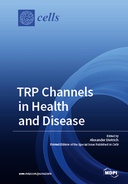Explore

TRP Channels in Health and Disease
Alexander Dietrich
2019
0 Ungluers have
Faved this Work
Login to Fave
Almost 25 years ago, the first mammalian transient receptor potential (TRP) channel was cloned and published. TRP channels now represent an extended family of 28 members fulfilling multiple roles in the living organism. Identified functions include control of body temperature, transmitter release, mineral homeostasis, chemical sensing, and survival mechanisms in a challenging environment. The TRP channel superfamily covers six families: TRPC with C for “canonical”, TRPA with A for “ankyrin”, TRPM with M for “melastatin”, TRPML with ML for “mucolipidin”, TRPP with P for “polycystin”, and TRPV with V for “vanilloid”. Over the last few years, new findings on TRP channels have confirmed their exceptional function as cellular sensors and effectors. This Special Book features a collection of 8 reviews and 7 original articles published in “Cells” summarizing the current state-of-the-art on TRP channel research, with a main focus on TRP channel activation, their physiological and pathophysiological function, and their roles as pharmacological targets for future therapeutic options.
This book is included in DOAB.
Why read this book? Have your say.
You must be logged in to comment.
Rights Information
Are you the author or publisher of this work? If so, you can claim it as yours by registering as an Unglue.it rights holder.Downloads
This work has been downloaded 336 times via unglue.it ebook links.
- 265 - pdf (CC BY-NC-ND) at Unglue.it.
Keywords
- 2D gel electrophoresis
- Adipose Tissue
- AP18
- bioavailable
- calcitonin gene-related peptide
- Calcium
- calcium signaling
- calcium signalling
- Cardiovascular system
- Cerebellum
- channel structure
- chemical probes
- chemicals
- chemosensor
- cuneate nucleus
- diacylglycerol
- dorsal column nuclei
- elementary immunology
- Endothelium
- EPSC
- GABAB
- graft versus host disease
- HEK293
- HSP70
- human medulla oblongata
- hypersensitivity
- Inflammation
- inflammatory bowel disease
- ion channel
- Ion Channels
- kinase
- lipid mediators
- lymphocytes
- MALDI-TOF MS(/MS)
- Manganese
- menthol
- mGluR1
- mucosal epithelium
- n/a
- nanoHPLC-ESI MS/MS
- Neutrophils
- NHERF
- organ toxicity
- overproduction
- Oxidative Stress
- Pathophysiology
- photochromic ligands
- Physiology
- platelets
- Pollutants
- production platform
- protein purification
- Proteomics
- Purkinje cell
- radiation
- regulatory T cells
- Saccharomyces cerevisiae
- salivary glands
- sensors
- SMAD
- small molecules
- sodium
- substance P
- sulfur mustard
- Th17
- Thrombosis
- topical
- Toxicology
- transient receptor potential
- transient receptor potential (TRP) channels
- transient receptor potential channels
- TRP channel
- TRP channels
- TRPA1
- TRPC
- TRPC channels
- TRPC3
- TRPC3 pharmacology
- TRPC4
- TRPC5
- TRPC6
- TRPM4 channel
- TRPM7
- TRPM8
- TRPV1
- TRPV2
- TRPV3
- TRPV4
- TRPY1
- ulcerative colitis
- xerostomia
- Yeast
Links
DOI: 10.3390/books978-3-03921-083-1Editions


